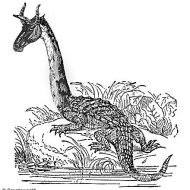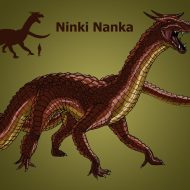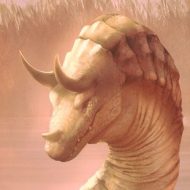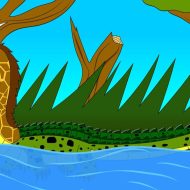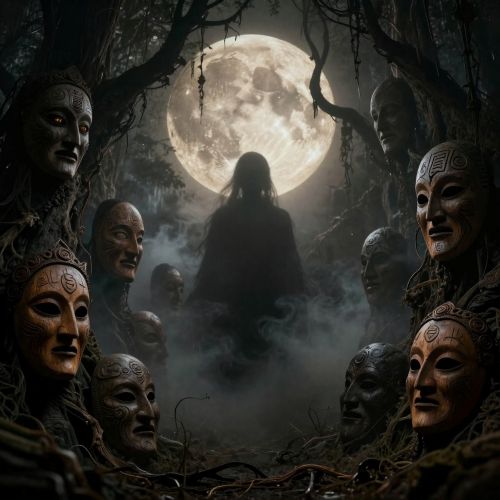Ninki Nanka : The Serpent of the Swamps
Listen
At a glance
| Description | |
|---|---|
| Origin | Mandinka Mythology |
| Classification | Hybrids |
| Family Members | N/A |
| Region | Gambia |
| Associated With | River Gambia, Death |
Ninki Nanka
Introduction
The Ninki Nanka is a fearsome creature rooted in the folklore of West Africa, particularly among the peoples of The Gambia, Senegal, and Sierra Leone. Described as a vast reptilian beast with dragon-like features, it dwells in the deep swamps and mangrove rivers of the region. The legend of the Ninki Nanka endures as both a cautionary tale and a powerful reflection of West African spirituality — where myth and morality often intertwine.
Its name, whispered with reverence and dread, evokes both fascination and fear. According to oral tradition, those who glimpse the Ninki Nanka seldom live to tell the tale. The creature embodies the natural dangers of the African wetlands and the unseen spiritual forces that govern life and death. For generations, it has served as a warning against arrogance, greed, and venturing too deep into forbidden places — where nature’s mysteries guard their secrets fiercely.
Physical Traits
The Ninki Nanka is often described as a colossal, snake-like creature measuring up to fifty meters in length. It glimmers with reflective scales of green and black that shimmer like polished obsidian under the tropical sun. Its head bears a crest or crown of feathers, and some accounts liken it to the neck of a giraffe or the snout of a crocodile. Others describe it as a hybrid between a dragon and a python — a monstrous serpent capable of moving silently through water or burrowing beneath the earth.
In certain tales, the creature is said to have legs like a lizard or a hippo, while in others, it is completely limbless, gliding with the grace of a river spirit. When it moves, the air grows heavy, and the water churns without wind. Traditional belief holds that the Ninki Nanka lives deep within the River Gambia and the surrounding wetlands, where its underground tracks meet with celestial waters, forming an eternal circle that sustains the balance of nature.
Other Names
Across the diverse cultures of West Africa, the Ninki Nanka goes by several names and interpretations. Among the Mandinka people, it is simply “Ninki Nanka,” meaning “Dragon” or “Great Serpent.” In some Fula and Wolof traditions, it is referred to as Nin-Ka-Naka or Ninki Naga, drawing parallels to the Indo-African word Naga for serpent spirits.
In Sierra Leone and Guinea, similar serpent-dragons appear in Mende and Temne folklore, representing guardian spirits of rivers and sacred groves. Though the names differ, the core idea remains — a divine or cursed creature that bridges the physical and spiritual realms, symbolizing both danger and divine retribution.
Powers and Abilities
The Ninki Nanka’s powers are as terrifying as its appearance. It is believed to bring death or deadly illness to anyone who sees it. Some say that to lock eyes with the creature is to invite certain doom — death striking instantly or within days. The only known defense, according to legend, is to carry a mirror. The Ninki Nanka, upon seeing its own reflection, is said to perish or retreat in confusion, unable to withstand its image.
Beyond its lethality, the Ninki Nanka is thought to embody elemental power. It commands water and mist, appearing at dusk or dawn when the river’s surface glows gold. Some elders believe it maintains the natural flow of rivers, ensuring fertility of the land while punishing those who defile sacred places. In this way, the creature represents both destruction and renewal — a spirit enforcing the balance between humanity and nature’s laws.
Modern Day Influence
The legend of the Ninki Nanka continues to thrive in contemporary West African culture. In 2006, the Centre for Fortean Zoology launched the “J. T. Downes Memorial Gambia Expedition” to investigate local reports of sightings. Eyewitnesses along the River Gambia described a massive, dragon-like reptile resembling the Chinese lung — elegant, long, and scaled. Although no evidence was found, the expedition drew international attention and revived global curiosity about Africa’s hidden cryptids.
Today, the Ninki Nanka Trails in The Gambia invite travelers to explore the creature’s myth through eco-tours, oral storytelling, and cultural performances. The route combines folklore, environmental education, and sustainable tourism, ensuring that the legend of the great serpent endures as both cultural heritage and conservation message. The Ninki Nanka has transcended its mythic origins to become a living emblem of Gambian identity — a reminder that even myths can inspire respect for the fragile harmony between humanity and nature.
Related Images
Source
Belcher, Stephen. African Myths of Origin. Oxford University Press, 2005.
Werner, Alice. Myths and Legends of the Bantu. George G. Harrap & Co., 1933.
Sarr, Assan. The Oral Traditions of The Gambia: Family Elders. Ohio University Press, 2016.
Wikipedia. (n.d.). Ninki Nanka. Retrieved from https://en.wikipedia.org/wiki/Ninki_Nanka
My Gambia. (2023, May). Gambian Folktales: Ninki Nanka. Retrieved from https://www.my-gambia.com/mymagazine/ninki-nanka-a-legendary-creature-of-the-gambia/
WADR – Our Heritage. (2024, October 27). Ninki Nanka: The Fascinating Creature from Gambian Folklore. Retrieved from https://wadr.org/our-heritage-ninki-nanka-the-fascinating-creature-from-gambian-folklore/
National Geographic. (2021, October 1). Exploring The Gambia’s New Ninki Nanka Trail. Retrieved from https://www.nationalgeographic.com/travel/article/exploring-gambias-new-ninki-nanka-trail
Frequently Asked Questions
Where is Ninki Nanka monster sanctuary?
Monster Sanctuary is a video game featuring various cryptozooids and the Ninki Nanka can be encountered in the Sun Palace.
Are there dragons in African mythology?
There are many types of African dragons: Ayida, who is a rainbow goddess, and Damballah, who is a cosmic rainbow serpent are the 2 best examples but Ninki Nanka is not technically a dragon.
Where does the Ninki Nanka live?
In West Africa, Ninki Nanka are believed to live in the swamps. The large and dangerous animal is said to take children who disobey their parents.
What is the story of the Ninki Nanka?
In 2006, a group of hunters from the Crocodile Forest Zone went to the country of Gambia to search for Ninki Nanka, but they were met with conflicting testimonies. Some of the hunters claimed that the animal looked like a Chinese dragon.
Where did the Ninki Nanka come from?
Ninki Nanka are legendary creatures in West African folklore. The descriptions of this animal vary, but most people believe it’s a reptilian or dragon-like creature. It’s believed to live in the swamps of West Africa and is very dangerous.


